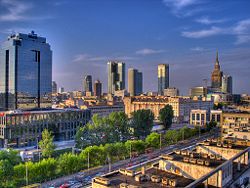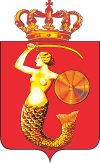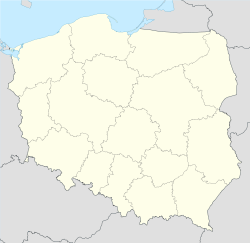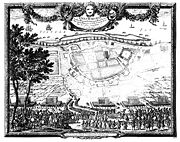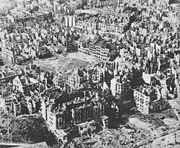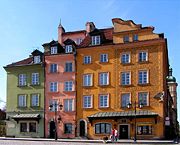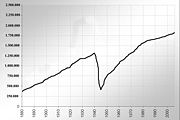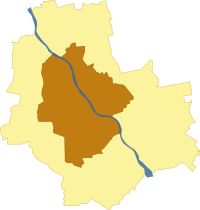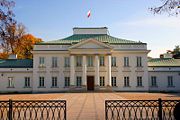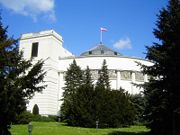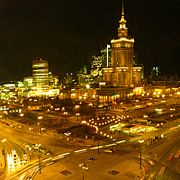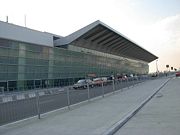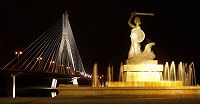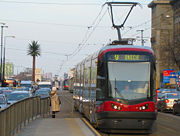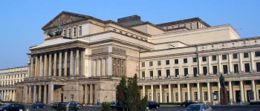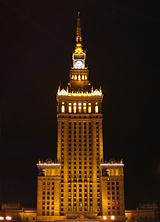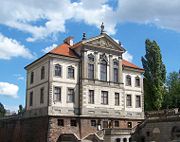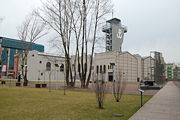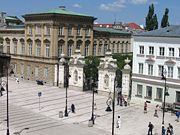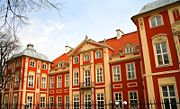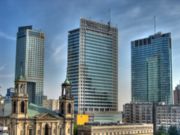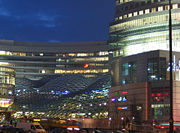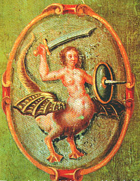Warsaw
2008/9 Schools Wikipedia Selection. Related subjects: Europe; European Cities
| Warsaw Warszawa |
|||
|
|||
| Motto: Semper invicta (Always invincible) | |||
| Coordinates: | |||
|---|---|---|---|
| Country | |||
| Voivodeship | Masovian | ||
| County | city county | ||
| City rights | turn of the 13th century | ||
| Boroughs |
18 dzielnicas
|
||
| Government | |||
| - Mayor | Hanna Gronkiewicz-Waltz ( PO) | ||
| Area | |||
| - City | 517 km² (199.6 sq mi) | ||
| - Metro | 6,100.43 km² (2,355.4 sq mi) | ||
| Elevation | 100 m (328 ft) | ||
| Population (2007) | |||
| - City | 1,704,717 | ||
| - Density | 3,297.3/km² (8,540/sq mi) | ||
| - Metro | 3,350,000 | ||
| - Metro Density | 549.14/km² (1,422.3/sq mi) | ||
| Time zone | CET ( UTC+1) | ||
| - Summer ( DST) | CEST ( UTC+2) | ||
| Postal code | 00-001 to 04-999 | ||
| Area code(s) | +48 22 | ||
| Car plates | WA, WB, WD, WE, WF, WH, WI, WJ, WK, WN, WT, WU, WW, WX, WY | ||
| Website: http://www.um.warszawa.pl/ | |||
Warsaw ( Polish: Warszawa [varˈʂava] ( listen); also known by other names) is the capital city of Poland and its largest city. It is located on the Vistula River roughly 370 kilometers (230 mi) from both the Baltic Sea coast and the Carpathian Mountains. Its population as of 2007 was estimated at 1,704,717, with a metropolitan area of approximately 3,350,000. The city area is 516.9 square kilometers (199.6 sq mi), with an agglomeration of 6,100.43 square kilometers (2,355.4 sq mi) (Warsaw Metro Area — Obszar Metropolitalny Warszawy). Warsaw is the 8th largest city in the European Union.
Warsaw gave its name to the Warsaw Pact, Warsaw Convention, Treaty of Warsaw and the Warsaw Uprising.
Etymology
An older spelling of Warsaw in Polish is Warszewa or Warszowa, meaning "owned by Warsz". Folk etymology attributes the city name to a fisherman Wars and his wife Sawa. Actually, Warsz was a nobleman (12th/13th century) who owned a village located at the site of today's Mariensztat neighbourhood.
The official city name in full is The Capital City of Warsaw ( Polish: Miasto Stołeczne Warszawa). Warsaw has been known in Latin as Varsovia. A native or resident of Warsaw is called Varsovian. See wiktionary:Warsaw for the name in other languages.
Geography
Location
Warsaw straddles the Vistula River. It is located in the heartland of the Masovian Plain, and its average altitude is 100 metres (330 ft) above sea level, although there are some hills (mostly artificial) located within the confines of the city.
Climate
Warsaw's climate is continental humid. The average temperature is −2 ℃ (28 ℉) in January and 18 °C (64 °F) in July. Temperatures may often reach 30 °C (86 °F) in the summer. Yearly rainfall averages 680 millimeters (26.8 in), the most rainy month being July.
| Weather averages for Warsaw | |||||||||||||
|---|---|---|---|---|---|---|---|---|---|---|---|---|---|
| Month | Jan | Feb | Mar | Apr | May | Jun | Jul | Aug | Sep | Oct | Nov | Dec | Year |
| Average high °C (°F) | 2 (33) | 5 (34) | 11 (44) | 12 (54) | 18 (65) | 24 (70) | 30 (86) | 31 (88) | 28 (82) | 15 (54) | 10 (42) | 5 (36) | 12 (53) |
| Average low °C (°F) | -5 (24) | -5 (24) | -1 (31) | 3 (37) | 9 (47) | 15 (52) | 16 (55) | 18 (54) | 9 (47) | 2 (40) | 0 (33) | -3 (27) | 4 (39) |
| Precipitation cm (inches) | 2.8 (1.1) | 2.6 (1) | 3 (1.2) | 3.8 (1.5) | 5 (2) | 6.6 (2.6) | 7.6 (3) | 7.1 (2.8) | 4.6 (1.8) | 4 (1.6) | 3.8 (1.5) | 3.6 (1.4) | 54.9 (21.6) |
| Source: Weatherbase 2008-02-11 | |||||||||||||
Districts
| District | Population | Area |
|---|---|---|
| Mokotów | 226,911 | 35.4 km² (13.7 sq mi) |
| Praga Południe | 185,077 | 22.4 km² (8.6 sq mi) |
| Ursynów | 143,935 | 44.6 km² (17.2 sq mi) |
| Wola | 142,025 | 19.26 km² (7.4 sq mi) |
| Bielany | 135,307 | 32.3 km² (12.5 sq mi) |
| Śródmieście | 134,306 | 15.6 km² (6 sq mi) |
| Targówek | 122,872 | 24.37 km² (9.4 sq mi) |
| Bemowo | 107,197 | 24.95 km² (9.6 sq mi) |
| Ochota | 91,643 | 9.7 km² (3.7 sq mi) |
| Białołęka | 76,999 | 74 km² (28.6 sq mi) |
| Praga Północ | 73,207 | 11.4 km² (4.4 sq mi) |
| Wawer | 66,094 | 79.71 km² (30.8 sq mi) |
| Żoliborz | 49,275 | 8.5 km² (3.3 sq mi) |
| Ursus | 47,285 | 9.35 km² (3.6 sq mi) |
| Włochy | 39,778 | 28.63 km² (11.1 sq mi) |
| Rembertów | 22,688 | 19.30 km² (7.5 sq mi) |
| Wesoła | 20,749 | 22.6 km² (8.7 sq mi) |
| Wilanów | 15,188 | 36.73 km² (14.2 sq mi) |
| Total | 1,700,536 | 517.90 km² (200 sq mi) |
Warsaw is a powiat (county), and is further divided into 18 boroughs, each one known as a dzielnica ( map), each one with its own administrative body. Each of the boroughs includes several neighbourhoods which have no legal or administrative status. Warsaw has two historic districts, called Old Town (Stare Miasto) and New Town (Nowe Miasto) in the borough of Śródmieście.
History
The first fortified settlements on the site of today's Warsaw were Bródno (9th/10th century) and Jazdów (12th/13th century). After Jazdów was raided, a new similar settlement was established on the site of a small fishing village called Warszowa. This settlement Warszowa (at present Warsaw) a Płock prince established (about 1300), Bolesław II Mazovian (from 1294 prince of entire Masovia). In the beginning of the 14th century it became one of the seats of the Dukes of Masovia, becoming the capital of Masovia in 1413. Upon the extinction of the local ducal line, the duchy was reincorporated into the Polish Crown in 1526. In 1529 Warsaw for the first time became the seat of the General Sejm, permanent since 1569. In 1573 Warsaw gave its name to the Warsaw Confederation, formally establishing religious freedom in the Polish-Lithuanian Commonwealth.
Due to its central location between the Polish-Lithuanian Commonwealth's capitals of Kraków and Vilnius, Warsaw became the capital of the Commonwealth and at the same time of the Polish Crown in 1596, when King Sigismund III Vasa moved the court from Kraków. Three times between 1655- 1658 the city was under the siege and three times it was taken and pillaged by the Swedish, Brandenburgian and Transylvanian forces. Warsaw remained the capital of the Polish-Lithuanian Commonwealth until 1795, when it was annexed by the Kingdom of Prussia to become the capital of the province of South Prussia. Liberated by Napoleon's army in 1806, Warsaw was made the capital of the newly created Duchy of Warsaw. Following the Congress of Vienna of 1815, Warsaw became the centre of the Congress Poland, a constitutional monarchy under a personal union with Imperial Russia. The Royal University of Warsaw was established in 1816.
Following the repeated violations of the Polish constitution by the Russians, the 1830 November Uprising broke out. However, the Polish-Russian war of 1831 ended in the uprising's defeat and in the curtailment of the Kingdom's autonomy. On 27 February 1861 a Warsaw crowd protesting the Russian rule over Poland was fired upon by the Russian troops. Five people were killed. The Underground Polish National Government resided in Warsaw during January Uprising in 1863–4.
Warsaw flourished in the late nineteenth century under Mayor Sokrates Starynkiewicz (1875–92), a Russian-born general appointed by Tsar Alexander III. Under Starynkiewicz Warsaw saw its first water and sewer systems designed and built by the English engineer William Lindley and his son, William Heerlein Lindley, as well as the expansion and modernization of trams, street lighting and gas works.
| “ | The history of contemporary civilization knows no event of greater importance than the Battle of Warsaw, 1920, and none of which the significance is less appreciated. | ” |
|
— Sir Edgar Vincent d'Abernon |
||
Warsaw became the capital of the newly independent Poland in 1918. In the course of the Polish-Bolshevik War of 1920, the huge Battle of Warsaw was fought on the Eastern outskirts of the city in which the capital was successfully defended and the Red Army defeated. Poland stopped on itself the full brunt of the Red Army and defeated an idea of the "export of the revolution."
During the Second World War central Poland, including Warsaw, came under the rule of the General Government, a Nazi colonial administration. All higher education institutions were immediately closed and Warsaw's entire Jewish population — several hundred thousand, some 30% of the city — herded into the Warsaw Ghetto. When the order came to annihilate the Ghetto as part of Hitler's " final solution" on April 19, 1943, Jewish fighters launched the Warsaw Ghetto Uprising. Despite being heavily outgunned and outnumbered, the Ghetto held out for almost a month. When the fighting ended, almost all survivors were massacred, only few managed to escape or hide.
By July 1944 the Red Army was deep into Polish territory pursuing the Germans toward Warsaw. Knowing that Stalin was hostile to the idea of an independent Poland, the Polish government-in-exile based in London gave orders to the underground Home Army (AK) to try to seize the control of Warsaw from the Nazis just before the Red Army's arrival. Thus, on 1 August 1944, as the Soviet army was nearing the city very fast, the Home Army and the civilian population started the Warsaw Uprising. The armed struggle, planned to last 48 hours, went on for 63 days, and eventually the Home Army fighters were forced to capitulate. They were transported to the POW camps in Germany, while the entire civilian population was expelled. Hitler, ignoring the agreed terms of the capitulation, ordered the entire city to be razed to the ground, and the library and museum collections taken to Germany or burned. Monuments and government buildings were blown up by special German troops known as Verbrennungs und Vernichtungskommando (burning and destruction detachments). About 85% of the city had been destroyed, including the historic Old Town and the Royal Castle. After the war, large prefabricated housing projects were erected in Warsaw to address the housing shortage. The city resumed its role as the capital of Poland and the country's centre of political and economic life. Many of the historic streets, buildings, and churches were restored to their original form. In 1980 Warsaw's historic Old Town was inscribed onto UNESCO's World Heritage list.
In 1995 the Warsaw Metro opened, and with the entry of Poland into the European Union in 2004, Warsaw is currently experiencing the biggest economic boom of its history. The opening match of the UEFA Euro 2012 is scheduled to take place in Warsaw.
Demographics
Warsaw has historically been a destination of internal and foreign immigration, especially from Central and Eastern Europe. For nearly 300 years it was known as the "New Paris" or "Second Paris". It was always a centre of European culture, existed as a major European city, and was a destination for many Europeans. Demographically it was the most diverse city in Poland, with as much as 20% of its population being either Jewish Poles or foreign born. World War II changed all of this, and to this day there is much less ethnic diversity than in the previous 300 years of the city's history. Most of the modern day population growth is based on internal migration and urbanization.
|
|
Municipal government
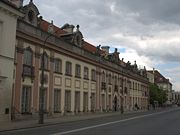
The mayor (the President of Warsaw)
According to the Warsaw Act (Ustawa warszawska) of October 27, 2002, the President of Warsaw carries out the executive duties in the city. The president's prerogative is, among others, governing the city-owned property that constitutes a major part of the city. The current President of Warsaw is Hanna Gronkiewicz-Waltz.
Municipal government
The Warsaw Act abolished all the former counties around Warsaw and formed one city powiat with a unified municipal government.
Legislative power in Warsaw is vested in a unicameral Warsaw City Council (Rada Miasta), which comprises 60 members. Council members are elected directly every four years. Like most legislative bodies, the City Council divides itself into committees which have the oversight of various functions of the city government. Bills passed by a simple majority are sent to the mayor (the President of Warsaw), who. may sign them into law. If the mayor vetoes a bill, the Council has 30 days to override the veto by a two-thirds majority vote.
Each of the 18 separate city districts has its own council (Rada dzielnicy). Their duties are focused on aiding the President and the City Council, as well as supervising various municipal companies, city-owned property and schools. The head of each of the District Councils is named the Mayor (Burmistrz) and is elected by the local council from the candidates proposed by the President of Warsaw.
Politics
As the capital of Poland, Warsaw is the political centre of the country. All state agencies are located there, including the Polish Parliament, the Presidential Office and the Supreme Court. In the Polish parliament the city and the area are represented by 31 MPs (out of 460). Additionally, Warsaw elects two MEPs.
Transport
Although many streets were widened, and new ones created, during rebuilding of Warsaw in 1950s, the city is currently plagued with traffic problems. Public transport in Warsaw is ubiquitous, serving the city with buses, tramways, and metro.
Roads and highways
Warsaw lacks a good circular road system and most traffic goes directly through the city centre. Currently two circular roads are under consideration. The first (called OEW, or Obwodnica Etapowa Warszawy) is planned to run approximately 10 kilometers (6 mi) from the city centre through the city streets and across two new bridges. The other is planned to become a part of both the A-2 motorway (itself a part of the European route E30 from Berlin to Moscow) and the S-7 ( Gdańsk– Kraków) express road, and will run through a tunnel under the southern area of Ursynów. It is to be completed between 2010 and 2012.
Airports
Warsaw has one airport, Warsaw Frederic Chopin Airport (usually referred to as Okęcie airport), located just 10 kilometers (6 mi) from the city centre. With over 70 international and domestic flights a day and with over 8,270,000 passengers served in 2006, it is by far the biggest airport in Poland. Immediately adjacent to the main terminal complex Terminal 1, is the Etiuda terminal, serving routes flown by low-cost carriers. Domestic flights operate from a domestic terminal, adjoining Terminal 1. A new Terminal 2 has been opened in March 2008 in order to alleviate current overcrowding, and to extend the airport's capacity by another 6 million passengers.
There are plans to convert disused military Modlin Airport, 35 kilometers (22 mi) north of the city centre, into the second Warsaw airport, mainly for low-cost carriers. It will not be ready for use before 2010 at the earliest.
There also are long-term plans to build an entirely new international airport. Its location has not yet been decided.
Public transport
Public transport in Warsaw includes, buses, trams (streetcars), metro and regional rail. The first three are operated by the ZTM (Zarząd Transportu Miejskiego, the Warsaw Transport Authority). There are also some suburban bus lines run by private operators.
There are three tourist routes: "T", a vintage tram running in July and August; bus "100" which runs on weekends and which operates the only double-decker bus owned by the city; and the "180" bus, a regular scheduled service that follows the "Royal Route" from the War Cemetery in the North, near the Old Town and down city's most prestigious thoroughfares – Krakowskie Przedmiescie, Nowy Swiat and Aleje Ujazdowskie – and terminating at Wilanów Palace.
Buses
Bus service covers the entire city, with approx. 170 routes totalling about 2,603 kilometers (1,617 mi) in length, and with some 1,600 vehicles. Between midnight and 5 am the city and suburbs are served by night lines.
Trams
The first tram (streetcar) line in Warsaw was opened on 11 December 1866. The last horse-drawn tram run on 26 March 1908. In the period between the world wars, the tram network was nationalized and extended significantly. After the German invasion of September 1939 the service was halted for approximately three months due to war damage, but the trams were back in service by 1940. In 1941 the present colours of the cars were introduced (yellow and red, in the colours of the Flag of Warsaw. Previously, trams were painted either white and red, or entirely red).
During the Warsaw Uprising the tram system was destroyed. The first tram line was reopened on 20 June 1945. Following the Second World War the tram network in Warsaw underwent fast development. The tracks reached all the principal parts of the city. However, in the sixties the official policy of both Polish and Soviet authorities promoted the use of Soviet oil, hence more buses were purchased and the tram network was shortened.
Currently the Tramwaje Warszawskie company runs 863 cars on almost 470 kilometers (292 mi) of track. Twenty-odd lines run across the city with additional lines opened on special occasions (such as All-Saints Day).
Metro
See also Warsaw Trolleybuses for the history of this type of transport. Trolleybuses no longer operate in Warsaw.
Railway
The first railway opened in Warsaw in 1845 (the Warsaw-Vienna Railway). Nowadays Warsaw is one of the main railway hubs in Poland.
The main railway station is Warszawa Centralna serving both domestic traffic to almost every major city in Poland, and international connections mainly to Germany, Czech Republic and former Soviet Union countries. There are also 5 other major railway stations and a number of smaller suburban stations.
The main railway line crosses the city in a tunnel (tunel średnicowy) approximately 2.2 kilometers (1.4 mi) long and running directly under the city centre. It is part of an east-west line connecting the Warszawa Zachodnia, Warszawa Centralna and Warszawa Wschodnia stations through the tunnel and a railway bridge over the Vistula River.
The principal railway stations are:
- Warszawa Centralna and Warszawa Śródmieście
- Warszawa Gdańska
- Warszawa Wileńska
- Warszawa Zachodnia
- Warszawa Wschodnia
Sports
Football
Legia Warszawa — men's football team (est. 1916), (Polish Champion: 1955, 1956, 1969, 1970, 1993,1994, 1995, 2002, 2006; Polish Cup winner: 1955, 1956, 1964, 1966, 1973, 1980, 1981, 1989, 1990, 1995, 1995, 1997, 2008; Polish SuperCup winner: 1989, 1994, 1997; 1st league in 2006/2007 season)
Polonia Warszawa — men's football team (est. 1911), (Polish Champion: 1946, 2000; Polish Cup winner: 1952, 2001; Polish SuperCup winner: 2000; 2nd league in 2006/2007 season)
Basketball
Polonia Warbud Warszawa - men's basketball team, 3rd in Era Basket Liga in 2003/2004 season.
Legia Warszawa (basketball) - basketball team
Volleyball
Volleyball was played in many places in Poland. It was very popular.
Culture
Theatre in the past
From 1833 to the outbreak of World War II, Plac Teatralny (Theatre Square) was the country's cultural hub and home to the various theatres.
The main building housed the Teatr Wielki from 1833–4, the Rozmaitości Theatre from 1836 to 1924 and then the National Theatre, the Reduta Theatre from 1919 to 1924, and from 1928 to 1939 — the Nowy Theatre, which staged productions of contemporary poetical drama, including those directed by Leon Schiller.
Nearby, in Ogród Saski ( Saxon Garden), the Summer Theatre was in operation from 1870 to 1939, and in the inter-war period, the theatre complex also included Momus, Warsaw's first literary cabaret, and Leon Schiller's musical theatre Melodram. The Wojciech Bogusławski Theatre (1922–6), was the best example of "Polish monumental theatre". From the mid-1930s, the Teatr Wielki building housed the State Institute of Dramatic Arts — the first state-run academy of dramatic art, with an Acting Department and a Stage Directing Department.
Plac Teatralny and its environs was the venue for numerous parades, celebrations of state holidays, carnival balls, and concerts.
Theatre
Warsaw is home to over 30 major theatres spread throughout the city, including the National Theatre (founded in 1765) and the Grand Theatre in Warsaw (established 1778).
Warsaw also attracts many young and off-stream directors and performers who add to the city's theatre culture. Their productions may be viewed mostly in smaller theatres and Houses of Culture (Domy Kultury), mostly outside Śródmieście (downtown Warsaw). Warsaw hosts the International Theatrical Meetings.
Music
Thanks to numerous musical venues, including the Teatr Wielki, the Polish National Opera, the Chamber Opera, the National Philharmonic Hall and the National Theatre, as well as the Roma and Buffo music theatres and the Congress Hall in the Palace of Culture and Science, Warsaw hosts many events and festivals. Among the events worth particular attention are: the International Frederick Chopin Piano Competition, the International Contemporary Music Festival Warsaw Autumn, the Jazz Jamboree, Warsaw Summer Jazz Days, the International Stanisław Moniuszko Vocal Competition, the Mozart Festival, and the Festival of Old Music.
Museums and art galleries
There are many museums and art galleries in Warsaw, the most notable are:
- National Museum - Muzeum Narodowe
- Zachęta Art Gallery - Zachęta Narodowa Galeria Sztuki
- Centre for Contemporary Art - Centrum Sztuki Współczesnej
- Museum of Modern Art - Muzeum Sztuki Nowoczesnej
- Museum of the Polish Army - Muzeum Wojska Polskiego
- Royal Castle - Zamek Królewski
- Warsaw Uprising Museum - Muzeum Powstania Warszawskiego
- Fryderyk Chopin Museum - Muzeum Fryderyka Chopina
- Historical Museum of Warsaw - Muzeum Historyczne miasta stołecznego Warszawy
- Polish History Museum - Muzeum Historii Polski
- Museum of Independence - Muzeum Niepodległości
- Museum of the History of Polish Jews - Muzeum Historii Żydów Polskich
- Museum of Sports and Tourism - Muzeum Sportu i Turystyki
Film
Since World War II Warsaw has been the second most important centre of film production in Poland. It has also been featured in numerous movies, both Polish and foreign, for example:
- Kanał and Korczak by Andrzej Wajda
- Eroica by Andrzej Munk
- The Decalogue by Krzysztof Kieślowski
- Miś by Stanisław Bareja
- The Pianist by Roman Polański
Education
Warsaw is one of the most important education centres of Poland. It is home to four major universities and over 62 smaller schools of higher education. The most important are:
- University of Warsaw (Uniwersytet Warszawski)
- Warsaw University of Technology (Politechnika Warszawska)
- Warsaw School of Economics (Szkoła Główna Handlowa)
- Warsaw University of Life Science (Szkoła Główna Gospodarstwa Wiejskiego)
- Cardinal Stefan Wyszyński University (Uniwersytet Kardynała Stefana Wyszyńskiego)
- Medical University of Warsaw (Warszawski Uniwersytet Medyczny)
- Military University of Technology (Wojskowa Akademia Techniczna)
- Academy of National Defence (Akademia Obrony Narodowej)
- Józef Piłsudski University of Physical Education in Warsaw (Akademia Wychowania Fizycznego w Warszawie)
- Fryderyk Chopin Academy of Music (Akademia Muzyczna im. Fryderyka Chopina)
- The Aleksander Zelwerowicz State Theatre Academy (Akademia Teatralna im. Aleksandra Zelwerowicza)
The overall number of students of all grades of education in Warsaw is almost 500,000 (29% of the city population; 2002). The number of university students is over 255,000.
Economy
In 2007 Warsaw was ranked the 67th world's most expensive city to live in. It was classified as a gamma world city (also known as a 'minor world city') on par with cities such as Rome and Beijing by Globalization and World Cities (GaWC) Study Group and Network from Loughborough University.
Business and commerce
Warsaw, especially its city centre ( Śródmieście), is home not only to many national institutions and government agencies, but also to many domestic and international companies. In 2006, 304,016 companies were registered in the city. Foreign investors' financial participation in the city's development was estimated in 2002 at over 650 million euro. Warsaw produces 12% of Poland's national income which per capita is estimated at around 290% of Polish average. The nominal GDP (PPP) per capita in Warsaw was about $28,000 in 2005 and $38,000 (€15,000) in 2007. It also has one of the fastest growing economies, with GDP growth at 6.5 percent in 2007 and 6.1 percent in the first quarter of this year.
At the same time the unemployment rate is one of the lowest in Poland, not exceeding 3%, according to the official figures.
The city itself collects around 8,740,882,000 złotys in taxes and direct government grants.
It has been said that Warsaw, together with Frankfurt, London and Paris, is one of the tallest cities in Europe. 11 of the tallest skyscrapers in Poland, 9 of which are office buildings, are located in Warsaw. The tallest structure, the centrally located Palace of Culture and Science, is the 7th tallest building in the European Union.
Warsaw hosts the headquarters of Frontex, the EU's border control agency.
Warsaw Stock Exchange
The Warsaw Stock Exchange (WSE) is according to many indicators the largest market in the region. Although Warsaw was home to a stock exchange from 1817, because of political changes after World War II, it could not be reopened after 1945. The WSE only started operating again in April 1991, after the reintroduction of the free-market economy. It is now the biggest stock exchange in the country, with more than 300 companies listed. Ironically enough, from 1991 until 2000 the stock exchange was located in the building previously used as the headquarters of the PZPR (Polish Communist Party). The capitalization of the exchange was US$440.92 billion (as at 28 December 2007). The Warsaw Stock Exchange offers both cash and derivative products under one roof. The city is now considered to be one of the most attractive business locations in Europe.
Industry
During Warsaw's reconstruction after World War II, the communist authorities decided that the city would become a major industrial centre. Numerous large factories were built in the city or just outside it. The largest were the Huta Warszawa Steel Works and two car factories.
As the communist economy deteriorated, these factories lost significance and most went bankrupt after 1989. Today, the Arcelor Warszawa Steel Mill (formerly Huta Warszawa) is the only major factory remaining. The FSO car factory produces cars mostly for export.
The number of state - owned enterprises is regularly decreasing and the number of companies with foreign capital growing. The largest foreign investors are Daewoo, Coca-Cola Amatil and Metro AG. Warsaw has the biggest concentration of electronics and high-tech industry in Poland and the growing consumer market perfectly fosters the development of the food-processing industry.
Tourist attractions
| Historic Centre of Warsaw* | |
|---|---|
| UNESCO World Heritage Site | |
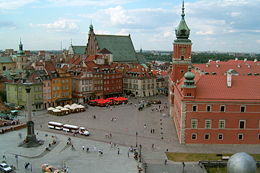 |
|
| State Party | |
| Type | Cultural |
| Criteria | ii, vi |
| Reference | 30 |
| Region** | Europe and North America |
| Inscription history | |
| Inscription | 1981 (4th Session) |
| * Name as inscribed on World Heritage List. ** Region as classified by UNESCO. |
|
- Although today's Warsaw is a fairly young city, it has a lot of tourist attractions. Apart from the Warsaw Old Town quarter, carefully reconstructed after World War 2, each borough has something to offer. Among the most notable landmarks of the Old Town are the Royal Castle, King Sigismund's Column, Market Square, and the Barbican.
- Further south is the so-called Royal Route, with many classicist palaces, the Presidential Palace and the Warsaw University campus. Also the popular Nowy Świat Street is worth mentioning.
- Warsaw's oldest public park, the Ogród Saski, is located within 10 minutes' walk from the old town.
- Warsaw's biggest public park and said to be the most beautiful is the Łazienki Park. It is also very old — established in the 17th century and given its current classical shape in late 18th century — is located further south, on the Royal Route, about 3 km from the Warsaw Old Town
- The Powązki Cemetery is one of the oldest cemeteries in Europe, full of sculptures, some of them by the most renowned Polish artists of the 19th and 20th centuries. Since it serves the religious communities of Warsaw, be it Catholics, Jews, Muslims or Protestants, it is often called a necropolis. Nearby is the Okopowa Street Jewish Cemetery, one of the largest Jewish cemeteries in Europe.
- To the north of the city centre is the site of the former Warsaw Ghetto.
- The borough of Żoliborz is famous for its architecture from the 1920s and 1930s. Between Żoliborz and the Vistula River is the Warsaw Citadel, a monument of 19th century military architecture.
- Former royal residence of king Jan III Sobieski — Wilanów Palace is notable for their baroque architecture and beautiful parks.
- Notable examples of contemporary architecture include the Palace of Culture and Science, a Soc-realist skyscraper located in the city centre, the Stadion Dziesięciolecia which used to be the biggest open-air market in Europe and the Plac Konstytucji with its monumental Social realism architecture. The central part of the right-bank (east) Praga borough it is a place where very run-down houses stand right next to modern apartment buildings and shopping malls.
- Ulica Kubusia Puchatka, probably the only street in the world named after Winnie-the-Pooh and located in the very centre of a metropolis.
- The modern architecture in Warsaw is represented by:
- Metropolitan Office Building at Plac Piłsudskiego (Pilsudski Square) by Sir Norman Foster
- Warsaw University Library (BUW) by Marek Budzyński and Zbigniew Badowski with a garden on the roof and beautiful view on the Vistula River
- Rondo 1 office building by SOM
- Zlote Tarasy retail and business centre
- Planned:
- Museum of the History of Polish Jews
- Museum of Modern Art
- "Kopernik" Science Centre (Copernicus)
- Złota 44 — Apartment tower of unique shape by Daniel Libeskind
- Lilium Tower - Apartment tower by Zaha Hadid
- Planned reconstructions:
- Saxon Palace
- Brühl Palace
Cityscape
Warsaw's mixture of architectural styles reflects the turbulent history of the city and country. During World War II, Warsaw was razed to the ground by bombing raids and planned destruction. After liberation, rebuilding began as in other cities of the communist-ruled PRL. Many of the old buildings that preserved in reconstructible form were eradicated in the 1950s and 1960s (e.g. Leopold Kronenberg Palace). Mass residential blocks were erected, with basic design typical of Eastern bloc countries.
Public spaces attract heavy investment, so that the city has gained entirely new squares, parks and monuments. Warsaw's current urban landscape is one of modern and contemporary architecture.
Warsaw Mermaid
The mermaid, or syrenka, is the symbol of Warsaw. This symbol can be found on the coat of arms of Warsaw and on statues throughout the city. Image of a mermaid have been used on the crest of Warsaw as its symbol, since the mid of the 14th century.The oldest existing armed seal of Warsaw is from the year 1390. It is a round seal bordered with the Latin inscription Sigilium Civitatis Varsoviensis. City records as far back as 1609 document the use of a crude form of a sea monster with a female upper body and holding a sword in its claws. In 1653 the poet Zygmunt Laukowski asks the question:
| “ | Warsaw of strong walls; why was the emblem Mermaid with sharp sword, given you by the kings? | ” |
|
—Zygmunt Laukowski |
||
The origin of the legendary figure is not fully known. Tellers of many stories and legends have tried to explain where she came from. The best-known legend, by Artur Oppman, it that a long time ago two of Triton's daughters set out on a journey through the depths of the oceans and seas. One of them decided to stay on the coast of Denmark and ever since we can see her sitting at the entrance to the port of Copenhagen. The second mer-maiden reached the mouth of the Vistula River and plunged into its waters. She stopped to rest on a sandy beach by the village of Warszowa. Local fishermen came to admire her beauty and listen to her beautiful voice. A greedy merchant also heard her songs; he followed the fishermen and captured the mermaid.
Another legend says that a mermaid once swam to Warsaw from the Baltic Sea for the love of the Griffin, the ancient defender of the city, who was killed in a struggle against the Swedish invasions of the 17th century. The Mermaid, wishing to avenge his death, took the position of defender of Warsaw, becoming the symbol of the city.
Every member of the Queen's Royal Hussars of the United Kingdom light cavalry wears the Maid of Warsaw, the crest of the City of Warsaw, on the left sleeve of his No. 2 (Service) Dress. Members of 651 Squadron Army Air Corps of the United Kingdom also wear the Maid of Warsaw on the left sleeve of their No. 2 (Service) Dress.
Famous people

One of the most famous people born in Warsaw is Maria Sklodowska-Curie, who achieved international recognition in Paris for her scientific discoveries. Another famous person from Warsaw is the musician Fryderyk Chopin. He was born in the village of Żelazowa Wola, about 60 kilometers from Warsaw, and when Fryderyk was seven months old, the family moved to Warsaw.
Warsaw in rankings
- Largest cities of the European Union - ranked 8th
- Most expensive cities - ranked 62nd out of 144
- Best cities in terms of quality of living - ranked 86th out of 100
- Best cities in terms of health and sanitation - ranked 100th out of 215
Sister Cities
|
references - city's official site -
